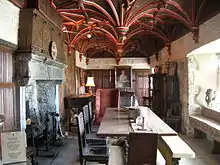Solar (room)
The solar was a room in many English and French medieval manor houses, great houses and castles, mostly on an upper storey, designed as the family's private living and sleeping quarters.[1] Within castles they are often called the 'Lords' and 'Ladies Chamber', or the 'Great Chamber'.[1]

The word solar has two possible origins: it may derive from the Latin word solaris meaning sun (often a room with the brightest aspect), or - as the solar provided privacy for its occupants, it may come from the Latin word, solus, meaning, "alone". [1]
In some houses, the main ground-floor room was known as the Great Hall, in which all members of the household, including tenants, employees, and servants, would often or could sometimes eat. Those of highest status would be at the end, often on a raised dais, and those of lesser status seated further down the hall. But a need was felt for more privacy to be enjoyed by the head of the household, a daytime space to talk and/or read and view part of the grounds, and, especially, by the senior women of the household. The solar was the key inner family room, for seclusion from the hustle, bustle, noise and smell (above all from cooking) of the great hall.[2]
The solar was generally smaller than the great hall as it was not expected to house so many people. It was a room of comfort and status, and usually included a fireplace and often decorative woodwork or tapestries/wall hangings.
The solar was almost ubiquitous among late castles across the British Isles, such as Broughton Castle, in Oxfordshire,[3] and Stokesay Castle in Shropshire.[4] In the medieval house of Great Dixter, in East Sussex, it consists of three rooms and a fireplace from the late 15th century.[5] In Windsor Castle its walls are painted green with gold stars.[2]
In manor houses of Normandy and northern France,[6] the solar was sometimes a separate tower or pavilion, away from the great hall to provide more privacy to the lord and his family.
The possibly related term grianán (from Irish grian, "the sun"; often anglicised as "greenawn") was used in medieval Ireland for a sunny parlour or reception room.[7] By extension it was used to refer to any summer palace or noble house.
Paradigm examples
In England from north to south:
- Edlingham Castle in Northumberland, castle in ruins but solar tower is mostly intact.[8]
- Longthorpe Tower, Peterborough, an extension to an existing fortified manor house.
- Tattershall Castle, Lincolnshire, has hall and large solar block later converted into a tower.[8]
- Beverston Castle near Tetbury, dating from the 13th century, has a surviving but ruined solar in the south tower of the west range, with a vaulted undercroft below.
- Highclere Castle near Newbury — its suite of rooms used by the owning family are demonstrated in the serial TV Downton Abbey.
- Great Dixter, in Northiam — home of the late British gardener and author Christopher Lloyd, has a recreated solar.[5]
See also
In much smaller large houses being synonymous as to all three terms:
- Parlour
- Drawing room (withdrawing room)
References
- "Solar". ancientfortresses.org. Retrieved 20 August 2017.
- Struan Reid Castle Life, p. 10, at Google Books
- Andor Gomme, Austin Harvey Gomme, Alison Maguire Design and Plan in the Country House: From Castle Donjons to Palladian Boxes, p. 21, at Google Books
- Anthony Emery Greater Medieval Houses of England and Wales, 1300-1500: Volume 2, East ..., p. 574, at Google Books
- "Solar". greatdixter.co.uk. Retrieved 20 August 2017.
- Christopher Gravett Norman Stone Castles (1): The British Isles 1066–1216, p. 16, at Google Books
- Hogan, Kilkenny; the Ancient City of Ossory, 1884, p.271
- Robert Liddiard (Editor) Late Medieval Castles at Google Books